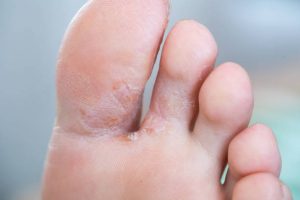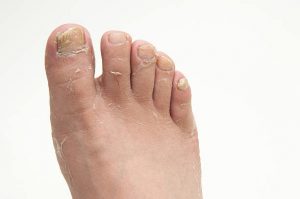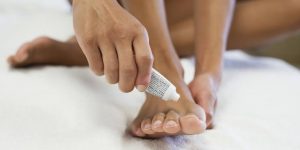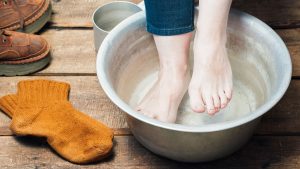Have you ever experienced athlete’s foot?
How did you know it was athlete’s foot?
What actions did you take when you discovered it?
How was it treated?
Did it reappear after treatment?
Image credit: istock photos
What is Athlete’s Foot?
Athlete’s foot is a fungal infection that usually affects the feet. It usually occurs between the toes (it can also affect the nails and soles of the feet) and is common in people who wear tight-fitting shoes and have sweaty feet. The moist, warm, and closed environment of sweaty feet in tight-fitting shoes makes it conducive for fungi to thrive as it feeds on keratin.
What is the Cause of Athlete’s Foot?
Athlete’s foot is majorly caused by different fungi that are grouped under dermatophytes which is also responsible for jock itch and ringworm.
Is Athlete’s Foot Contagious?
Athlete’s foot can spread from person to person; therefore, it is contagious. It directly spread when an uninfected person touches the affected area of an infected person; it indirectly spread when a person comes in contact with infected skin particles left on shoes, socks, towels and floors.
Risk Factors
Athlete’s foot affect people of different ages and occupation. An individual does not have to be an athlete to have it.
A person is at risk of having athlete’s foot when he walks barefooted on a moist ground infected with fungi like public baths, swimming pools, and locker rooms.
People who also have an auto immune disease, poor immune system and diabetes are also at risk of developing athlete’s foot in the event of small cuts or injury on the feet.
People who constantly wear tight-fitting covered-shoes and have sweaty feet
Sharing socks, shoes, towels with people can put a person at risk of having athlete’s foot.
Putting your legs dirty water on waterlogged areas during rainy season.
Symptoms
Athlete’s foot presents as dry scaly, flaky and red skin on the soles and toe webs of the feet; burning, itching or stinging sensation between the toes; blisters, cracking and peeling of the skin between the toes with itching.

Image credit: istock photos
People with athlete’s foot may not have any symptoms of itching, burning or stinging sensation but can have smelly feet.

Image credit: istock photos
If athlete’s foot is not attended to on time, it may spread to the toenails and cause discolored, crumby, and thick toenails which eventually pulls off from the nail bed. It may even spread to the fingernails and other parts of the body like the groin through itching if the hands are not washed immediately after touching the area affected.
Diagnosis
Athlete’s foot is diagnosed with its symptoms by doctors. To rule out other conditions and confirm the diagnosis, a skin sample from your foot can be taken for testing in the lab.
Treatment
If the athlete’s foot is mild, Over the counter (OTC) antifungal medications may be recommended in treating the infection.
In case of severe form of athlete’s foot, oral antifungals with prescription can be recommended.
Antifungals can be in various forms such as solutions, creams, sprays, powders, and tablets.

Applying antifungal cream
Image credit: istock photos
However, it is important to note that fungal infections take a longer time to heal. It is advisable to continue use of the topical medications (creams, sprays, and powders) even after the skin has healed up.
Home Remedy for Athlete’s Foot
Feet should be washed with soap and water and properly dried after washing, especially between the toe webs
Soaking the feet in diluted vinegar or salt solution can help clear up blisters.

Soaking feet in vinegar solution.
Image credit: Pinterest
Regularly change shoes and socks. Avoid repeating a particular sock multiple time.
Regularly wash towels and avoid sharing them.
Prevention
Since athlete’s foot can affect anyone, it is best to ensure that your feet, shoes, and socks are always clean and dry by
- Cleaning between the toes when washing the feet
- Always keep the feet dry.
- Try wearing loose-fitting shoes that have good ventilation especially when there is heat.
- If you wear shoes almost throughout the day, you can remove your shoes in-between to allow air to touch your feet to reduce moisture accumulation in the feet.
- Avoid repeating a single shoe every day. After shoes are removed, air dry them.
- Avoid putting on damp socks and stockings. Wear socks made from cotton, silk or wool as they draw moisture away from the feet.
- Wear pool slippers when walking around public places.
- Avoid sharing shoes, socks, and towels.
- During rainy season, after coming in contact with dirty water in areas of floods, soak your feet in salt water solution or diluted vinegar.

Ezike Nonye is a Pharmacist who completed her Bachelor degree from University of Lagos (B.Pharm). She is currently exploring digital marketing analytics as a novel field in Pharmacy practice while also interning at the Federal Medical Center (FMC) Abeokuta, Ogun State, Nigeria. She is a graphic designer, a blogger and an entrepreneur. She is passionate about creating new things from nature and believes that there is no limitation to what you can achieve. She is a Christian and loves writing and open to new ideas and skills.


